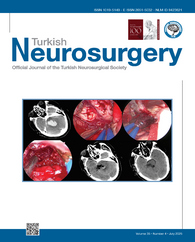2Usak Training and Research Hospital, Department of Radiology, Usak, Türkiye DOI : 10.5137/1019-5149.JTN.47590-24.3 AIM: To evaluate pial arteriovenous fistulas (AVFs), focusing on the radio-anatomic architecture and contemporary endovascular devices and techniques.
MATERIAL and METHODS: Sixteen patients with congenital pial AVFs who underwent endovascular treatment between 2002 and 2023 at a single institution were included in this review. This retrospective study was approved by the Institutional Review Board. The study was descriptive and involved no statistical comparisons.
RESULTS: The study included 16 patients (6 female patients, 10 male patients) with a mean age of 19.93 ± 21.1 years (range: 1?63 years). Nine (56.25%) were pediatric patients, six (37.5%) of whom were younger than 5 years. Five patients (31.25%) had more than one feeding artery, whereas 11 (68.75%) had a single feeding artery. One patient had two separate fistulas. All fistulas were successfully occluded without complications. Four patients (25%) were treated with glue alone, four (25%) with coils alone, five (31.25%) with a non-adhesive liquid agent alone, and three (18.75%) with a combination of coils and a non-adhesive liquid agent. Venous sinus thrombosis occurred in two patients (12.5%) in the early postoperative period; both cases resolved without permanent deficits.
CONCLUSION: Pial AVF is a rare intracranial vascular malformation. Endovascular treatment using liquid embolic agents, coils, or a combination of these techniques is effective.
Keywords : Glue, Coils, Non-adhesive liquid agent, Arteriovenous fistula, Pial AVF




